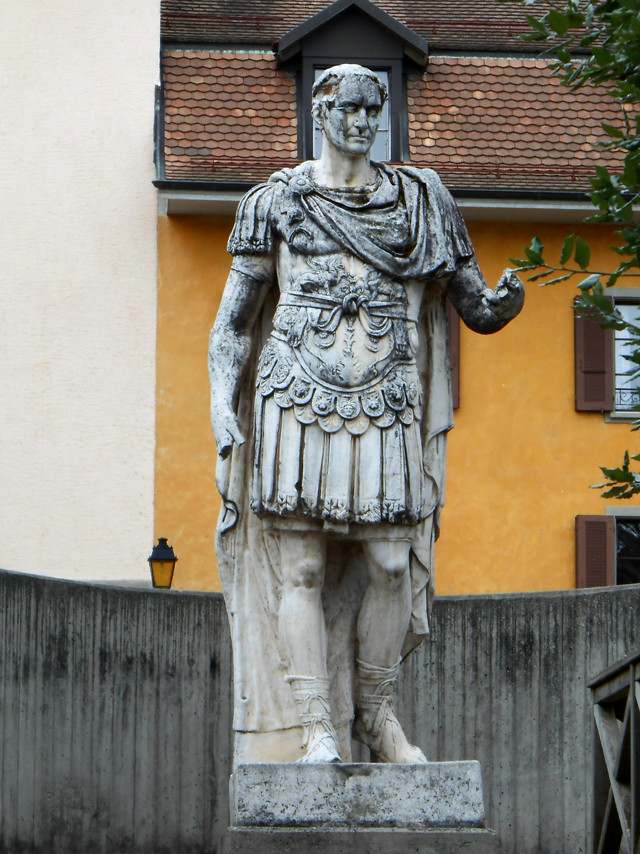
by John Copeland Friday, June 17, 2016

Julius Ceasar, for whom two months in the Gregorian Calendar of the year are named. Credit: ©Traumrune / Wikimedia Commons / CC-BY-SA-3.0.
As months go, July has some distinctive qualities. For one thing, it is one of only two months in the Gregorian calendar named for a person; in this case, Julius Caesar. (The other is August, which honors Julius Caesar’s great nephew and the first Roman emperor, Gaius Octavius, better known as Augustus.) The remaining months of the year are named for gods, goddesses, festivals or numbers.
The Romans originally called July Quintilis, Latin for fifth, as it was the fifth month of the ancient Roman calendar. Caesar, during his reign, reformed the old Roman calendar because its inaccuracies caused the timing of the months to drift with respect to the seasons; January, for example, had begun to occur in autumn. This reformation created the Julian calendar, which closely resembles the Gregorian calendar we use today and was more closely synced to the seasons than the preceding Roman versions.
After Caesar’s assassination in 44 B.C., the Roman Senate renamed Quintilis, changing the name of the month to Julius. Caesar had been born during Quintilis, so it was a natural choice to honor him.
Although six months of the year have passed, the first day of July is not the mid-point of the year. As the 183rd day of the year, with 182 days before it and 182 yet to come, the true middle of the year is July 2. In a non-leap year, we reach the exact middle at midday on July 2. During a leap year, like 2016, and if you are in a locale that observes daylight savings time, we reach the exact mid-point at 1:00 a.m. on July 2.
July is also when the hot, sultry dog days of summer begin. Today, many people believe that the term “dog days” refers to the conspicuous lazi"ess of domesticated dogs and humans “dogging” around, or being “dog tired,” during the “ottest days of the summer. These terms have nothing to do with the original meaning of the phrase, but they’ve become part of our common vernacular today. "
According to John Brady’s history of our calendar, “Clavis Calendaria,” published in 1813, the Romans believed this period in July, “dies caniculares” in Latin, to be an evil time “when the seas boiled, wine turned sour, dogs grew mad, and all creatures became languid, causing to man burning fevers, hysterics, and phrensies [sic].”
In reality, the dog days referred to when the star Sirius is brightest in the sky. The ancient Greeks and Romans considered Sirius to be the “dog star” because it is the brightest star in the constellation Canis Major (Latin for “big dog”). They noticed that these hottest days of the year seemed to occur when Sirius and the sun rose and set together, and they assumed that the two stars were acting in league to create the “days of great heat.” (If you watch the sunrise in July or early August, you will still see the sun and Sirius climbing into the sky together.)
Alas, the Greeks and the Romans did not have it quite right — the dog days, when Sirius rises with the sun, are not necessarily the hottest days of the year. And our summer heat is not due to the added radiation from far-away Sirius, regardless of its brightness. Warm summer weather results from Earth’s tilt on its axis. During the boreal summer months, the planet’s orientation allows sunlight to strike the Northern Hemisphere more directly than in the other seasons. (Because Earth’s oceans heat up and cool down slowly, the peak warming effect from this summer sunlight is delayed by about a month and a half after the summer solstice in June, when the sun’s rays are most intense.)
Another reason the dog days don’t correspond neatly with the heat is that the stars in Earth’s sky shift independently of our calendar seasons. The conjunction of Sirius rising and falling with the sun has changed over the millennia because of the precession of the equinoxes, which is the gradual drifting of the constellations over time relative to Earth: about 1 degree every 50 years. Today, the constellations have moved about 41 degrees relative to where they were in the ancient Roman sky.
This means that the dog days of ancient Rome weren’t the dog days of today. They used to last from about July 24 to Aug. 24, but now, the dog days fall between July 3 and Aug. 11. Several millennia from now, the conjunction of Sirius and the sun will not even occur during the summer. And roughly 13,000 years from now, Sirius will be rising with the sun in mid-winter. Then, we will be referring to the dog days of winter. But for now, at least, most of us still see the dog days as a time to beat the heat and head out on vacation.
© 2008-2021. All rights reserved. Any copying, redistribution or retransmission of any of the contents of this service without the expressed written permission of the American Geosciences Institute is expressly prohibited. Click here for all copyright requests.